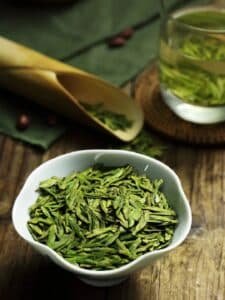☕ Understanding Chinese Tea: A 20-Year Taster’s Perspective
Longjing, Tie Guan Yin, Pu-erh, White Tea, and Da Hong Pao Explained
👋 Introduction
As someone who has spent over 20 years tasting and sourcing Chinese tea, I’m often asked:
“What’s the difference between Longjing, Tie Guan Yin, Pu-erh, White Tea, and Da Hong Pao?”
Chinese tea can seem mysterious to newcomers. But with a basic understanding of flavor profiles, origins, and craftsmanship, the world of Chinese tea becomes both accessible and fascinating.
Let’s explore the iconic categories of Chinese tea, and compare them with similar varieties so you know how to choose what suits you best.

🟢 Longjing (Dragon Well)
China’s Most Famous Green Tea
- Origin: Zhejiang Province, mainly around West Lake, Hangzhou
- Type: Green tea
- Flavor: Toasted chestnut, sweet grass, umami
- Processing: Pan-fired to prevent oxidation
West Lake Longjing vs Regular Longjing
| Feature | Regular Longjing | West Lake Longjing |
|---|---|---|
| Region | Various provinces | Core area in Hangzhou (e.g., Lion Peak) |
| Aroma | Grassy | Roasted chestnut, floral |
| Price Range | $10–$40 / 100g | $60–$300 / 100g (genuine origin) |
| Craftsmanship | Machine-processed | Hand-picked, hand-fired |
Buying Tip: Look for Pre-Qingming (Ming Qian) harvests and verify regional authenticity.
Explore origin-verified green teas.
Longjing vs Other Green Teas
| Tea | Origin | Aroma Profile | Taste Profile | Appearance |
| West Lake Longjing | Zhejiang – Hangzhou | Roasted chestnut, orchid | Smooth, sweet, low bitterness | Flat, yellow-green leaves |
| Huangshan Maofeng | Anhui – Huangshan | Floral, nutty | Fresh, soft, lightly sweet | Fine buds with fuzz |
| Biluochun | Jiangsu – Taihu | Fruity, floral | Strong, slightly bitter then sweet | Spiral rolled buds |
🌸 Tie Guan Yin (Iron Goddess of Mercy)
The Floral Queen of Oolongs
- Origin: Anxi, Fujian Province
- Type: Semi-oxidized oolong
- Flavor: Floral, orchid, creamy, buttery
- Aroma: Bright and perfumed
Traditional vs Modern Tie Guan Yin
- Traditional: Roasted, nutty, complex
- Modern (Qing Xiang): Greenish, aromatic, delicate
Buying Tip: Look for tightly rolled pellets with lasting fragrance and multi-steep capability.
Tie Guan Yin vs Other Oolongs
| Tea | Aroma Profile | Taste | Roast Level | Best For |
| Tie Guan Yin (Modern) | Floral, milky | Smooth, fragrant | Light | Beginners & floral lovers |
| Rou Gui | Spicy, cinnamon | Bold, layered | Medium-Heavy | Lovers of intense flavor |
| Dan Cong – Mi Lan Xiang | Honey, fruity, lychee | Full-bodied, sweet | Light-Medium | Aroma connoisseurs |
🌿 Pu-erh Tea
The Living Tea That Improves with Age
- Origin: Yunnan Province
- Type: Fermented (Sheng or Shou)
- Flavor: Earthy, woody, sweet or mushroomy
Sheng (Raw) vs Shou (Ripe)
| Sheng Pu-erh | Shou Pu-erh |
| Naturally aged | Artificially fermented |
| Bold, astringent | Smooth, mellow |
| Great for aging | Great for digestion |
Buying Tip: Choose Pu-erh with clear info on origin, vintage, and factory.
When to Choose Sheng or Shou
| Type | Fermentation Method | Taste Profile | Beginner Friendly | Best Season |
| Sheng | Natural aging | Bitter start, sweet finish | ❌ | Summer |
| Shou | Wet-pile fermentation | Smooth, earthy, warming | ✅ | Winter & digestion |
🌼 White Tea
Minimal Processing, Maximum Purity
- Types: Silver Needle, White Peony, Shou Mei
- Flavor: Lightly sweet, floral, honeyed with age
- Processing: Sun-withered and air-dried
Comparing Silver Needle, White Peony, and Shou Mei
| Tea | Plucking Standard | Aroma | Price Tier | Best Use |
| Silver Needle | Single buds | Delicate, floral | $$$ | Gifting, luxury tasting |
| White Peony | Bud + leaves | Fresh, light sweet | $$ | Daily tea lovers |
| Shou Mei | Mature leaves | Herbal, earthy | $ | Aging, boiling, health |
Buying Tip: Aged white tea (3+ years) develops medicinal and fruit notes, suitable for storage.
🔥 Da Hong Pao (Big Red Robe)
The King of Rock Teas
- Origin: Wuyi Mountains, Fujian
- Type: Roasted Oolong (Yancha)
- Flavor: Roasted nuts, caramel, dried fruit, mineral finish
Buying Tip: Look for mentions of “Yan Yun” (rock rhyme) and roast intensity (light, medium, heavy).
Da Hong Pao vs Other Wuyi Rock Teas
| Tea | Aroma & Flavor | Roast Level | Rock Feel | Price Tier |
| Da Hong Pao | Dried fruit, caramel | Medium-Heavy | Medium-Strong | $$$ |
| Shui Xian | Woody, floral | Medium | Medium | $$ |
| Rou Gui | Spicy, cinnamon | Medium-Heavy | Strong | $$-$$$ |
☑ How to Buy Authentic Chinese Tea
- Verify Origin: Protected regions matter (e.g., West Lake, Anxi, Yunnan)
- Harvest Season: Early spring = fresher, higher grade
- Smell the Dry Leaf: Should smell natural and pleasant
- Ask Questions: Real producers know their tea’s full story
- Avoid Suspiciously Cheap Tea: Especially for named origins like Longjing
Shop curated Chinese teas at Pure China Tea
🧠 Final Thoughts from a Tea Veteran
Tea isn’t just a drink—it’s a time capsule, a bridge between regions, and a personal ritual. Whether you sip the floral whisper of Tie Guan Yin or savor the boldness of Da Hong Pao, choose quality and let the leaf speak.
